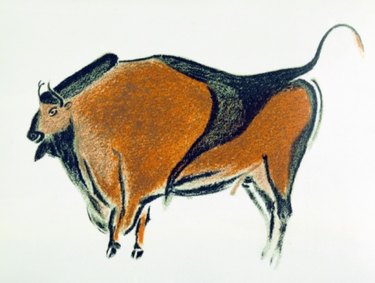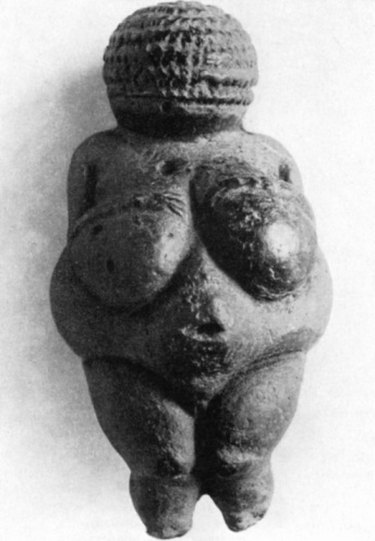
Humans first made art during the Stone Age, but it evolved drastically as the eras moved from Paleolithic to Neolithic. The methods for making art became more varied as tools were developed and humans learned to make crafts like pottery. While it is believed that both Paleolithic and Neolithic people made art for ritualistic purposes, this intent was more apparent during Neolithic times. To understand Stone Age art we must first look at how people lived.
Paleolithic People
Video of the Day
Paleolithic society was made up of hunters and gatherers from about 2 million to 9000 B.C. Everything they needed, from firewood to food, had to be found. Humans used rocks to hunt but creativity evolved when they chipped away at the rocks to make them function better. These rocks became tools humans could use to make art. Paleolithic people later made other tools of bone and flint. Because of the cycles of nature, they had quiet moments where they could spend time making art. They were the first humans to visually represent the things they found in the natural environment.
Video of the Day
Neolithic People
Neolithic people lived during the New Stone Age, from 9000 to 8000 B.C. Their society was different from Paleolithic culture because they lived in settled communities, domesticated animals and cultivated crops. As they improved their society they developed skills like spinning, weaving and building, but they had less time for fine art like painting. Because of this, Neolithic art is most known for crafts and architecture. They also made tombs and religious objects.
Paleolithic Painting
The most famous pieces of Paleolithic art are cave paintings, particularly the ones found at Altamira, Spain, and Lascaux, France. Examples such as the animals in the Lascaux caves (created around 15,000 B.C.) are very detailed and show lively animals painted realistically. Shading highlights the forms of the animals and makes them appear more lifelike. It is unknown why Paleolithic people painted these pictures, though they may have been ritualistic.
Neolithic Painting
Neolithic people also painted; they were the first to apply pigment to a man-made surface. The Turkish site at Catal Huyuk (6000 B.C.) was once a large complex of plaster and mud brick buildings. Paintings still adorn the remains of the walls. Hunting scenes show animals that are simpler and less life-like. Scholars do know these paintings were part of a ritual to honor a deity.
Paleolithic and Neolithic Sculpture

Paleolithic people made small carvings out of bone, horn or stone at the end of their era. They used flint tools. Venus of Willendorf (25,000 to 20,000 B.C.) is an example of such a carving. This small image of a full figured woman is made from stone and the details are crudely carved. Neolithic artists were different than Paleolithic people because they developed skills in pottery. They learned to model and made baked clay statues. A goddess figure found at Catal Huyuk depicts a seated woman flanked by two leopards.